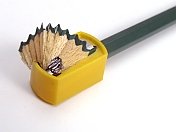Manual Pencil Sharpeners
Portability, and
ease-of-use, are two of the many reasons why you should have Manual
Pencil Sharpeners as part of your drawing toolbox.

Manual Pencil sharpeners are pure simplicity.
If you compare today's manual sharpeners to the early versions, you would not see much of a difference in their designs. A blade encased within a housing, with an opening that provides access to the blade.
Stick the business end of a pencil in the opening, and twist.
The inventor of the pencil sharpener may have been Bernard Lassimone, a French mathematician. He applied for the first patent (French patent #2444) on pencil sharpeners in 1828.
In 1847, Therry des Estwaux invented an improved mechanical sharpener.
Before pencil sharpeners, pencils were sharpened with a knife. This did the job, but tended to create a rather crude point, and wasn't all that safe.
Manual sharpeners come in a fantastic array of styles, some that are quite whimsical. If you were to do a search on the web for pencil sharpener collections, you'd find hundreds of unique pencil sharpeners in the shapes of...
Because of the shear number of these different styles, there are many people who have become passionate collectors of these fun pencil sharpeners. Because manual sharpeners are so inexpensive, portable and compact, they are perfect for a quick refresh on the point of your pencil. This basic tool will take some careful skill when sharpening soft-lead pencils. These would include...
So, unless you have surgeon-like motor skills, you may find it a bit of a challenge to sharpen soft leaded pencils. As you might have guessed, there are different qualities of manual sharpeners. Try to get the higher end sharpeners with replaceable steel blades, and with 2 different sized openings... some drawing pencils don't come in "standard" sizes. Also, find one with a receptacle for catching the shavings. Otherwise, you'll have to work with a trash can nearby. With it's simplicity and portability, the manual pencil sharpener is a must-have for every artist's drawing toolbox. |
Here is a manual sharpener for you to try out. |
Subscribe to my Newsletter